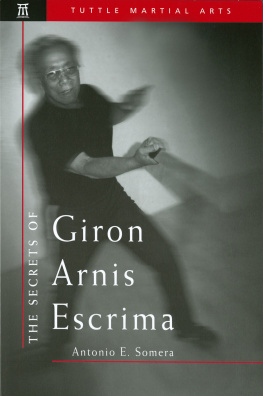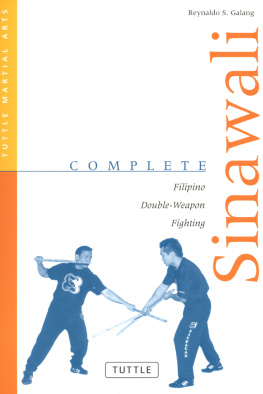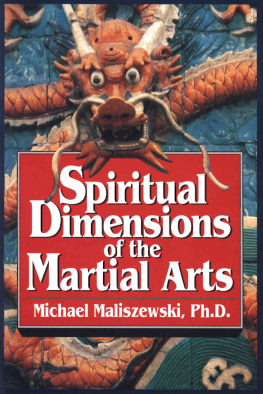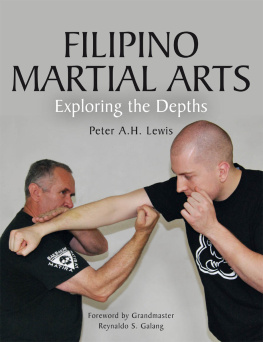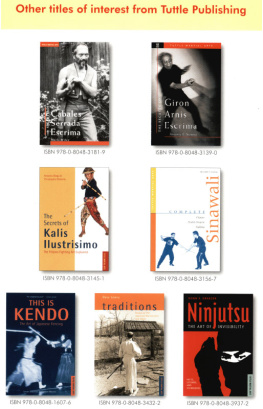Acknowledgments
First and foremost I would like to thank Grandmaster Angel Cabales for sharing his art with me and asking me to write this book.
I would like to thank my parents for giving me the opportunity to begin the study of the martial arts at a young age and to acquire the knowledge that I possess.
I would like to thank Mary J. Hadicke-Wiley, Robert Burns, Sihu Carlos Aldrete, and Master Ian A. Cyrus for taking the time to proofread the original manuscript, Guro David R. Smith for photographing the technique sequences, and Guro Guy Dranoff for posing with me in the photographs.
I would like to also thank those individuals who have offered their suggestions in the writing and presentation of this manuscript: Guro Joe Breidenstein, Guro Fred Degerberg, Master Reynaldo S. Galang, Guro Fred Lazo, Guro Alan McLuckie, Master Darren Tibon, and Guro Mike Young. My research and documentation of the martial arts is inspired by the ground-breaking work of the late Donn F. Draeger and his associates Robert W. Smith and Quintin T. Chambers. Their collective and individual texts have long been trusted reference sources for me and subjects of my admiration.
Many thanks to the Filipino Warrior Arts Association for their perpetuation of Filipino martial culture and sponsorship of Cabales Serrada Escrima.
Finally, I would like to thank the staff of the Charles E. Tuttle Company, their martial arts publications continue to be a step above the rest.
Afterword
Although no single text alone is sufficient for ones development in a martial art, it is my hope that this volume has given you an idea of the background, development, and foundation of the Serrada Escrima system of Grandmaster Angel Cabales. Although this volume covers a great deal of the Serrada Escrima system, it is in no way meant to be a substitute for a qualified instructor, whose instruction is essential for proper development in this warrior art.
I now leave you with a popular saying of Grandmaster Cabales. When asked about combatting styles that make use of sticks 30 inches and longer, he said, I dont care if you got a mile-long stick, Ill block it with 18 inches. No art must be viewed as better or worse than all others, just different. As there are different tastes for different people, so are there different martial arts. Your ability to perform in combat is rooted in the confidence and faith you have in your art. Grandmaster Angel Cabales was the epitome of such qualities.
Mabuhay ang Escrima (Long Live Escrima)
Table of Contents
Published by the Charles E. Tuttle Company, Inc.
of Rutland, Vermont & Tokyo, Japan
with editorial offices at
Osaki Shinagawa-ku, Tokyo 141-0032
1994 by Charles E. Tuttle Publishing Co., Inc.
All rights reserved
LCC Card No. 93-61409
ISBN 0-8048-1913-0
ISBN 978-1-4629-0760-1 (ebook)
www.tuttlepublishing.com
First edition, 1994
Fifth reprinting, 1998
PRINTED IN SINGAPORE

Disclaimer
Please note that the publisher of this instructional book is NOT RESPONSIBLE in any manner whatsoever for any injury that may result from practicing the techniques and/or following the instructions given within. Since the physical activities described herein may be too strenuous in nature for some readers to engage in safely, it is essential that a physician be consulted prior to training.
Foreword
by Grandmaster Angel Cabales
Founder, Cabales Serrada Escrima
For many years I have received proposals from people for writing a book on my style of Escrima. I had turned down all of these offers, feeling uneasy with the idea of my art being available in pictures for anyone to see. However, with the spread of my art as it is going, and my inability to preserve it everywhere, I find it time to document Cabales Serrada Escrima.
I have chosen Mark Wiley, one of my few chosen master instructors, to present my work. I highly recommend this and every book in Marks collection to anybody who seeks the ultimate, complete documented knowledge of an art. Mark Wiley is, in my opinion, an honest and humble person and a true master in every sense.
Foreword
by Mike Young
Contributing Editor, M.A. Training
I have known Mark Wiley for many years now and have watched him grow in the competitive world of the martial arts. I first got to know him years ago while he was in his infant stage of the game, trying to find the ever elusive secret of the martial arts.
After many long heart-to-heart talks along with many bone-to-bone bruises and contusions with him, I can now see that Mark found the right path in his pursuit towards martial arts excellence. His dedication to pursue top masters in many areas of the martial arts, from Muay Thai, Wing Chun, Savate, and boxing, to the Filipino martial arts, displays to me that his thirst for knowledge has not yet been quenched. This attribute is the key to achieving greatness in the martial arts.
In this book, Mark has focused on one martial art form, Escrima, and has conveyed the essence of the art. I highly recommend this and all of his other books.
Glossary of Filipino Terms
abakadas: the angles of attack
abaniko: a fanning strike
agaw: a disarming technique
aldabis sa ilalim: a backhand strike to the knee (Angle Nine)
anggulo: any one of the angles of attack
anim: the number six
anting-anting: an amulet or charm of supernatural power
apat: the number four
arko: a twirling motion of the stick
Arnis de Mano: (lit., armor of the hands) a fencing art developed in the Philippines
bahi: a tree with a grain that looks like the scales of a snake
balikat: the shoulder
bantay kamay: the Alive Hand
bartikal: a backhand strike to the collarbone (Angle Two)
baston: a cane or stick used in Escrima, Arnis, and Kali
bigay galang: the courtesy salutation
bisig: the forearm
bolo: a type of machete used in Escrima
Bothoan: a secret, ancient school of weaponry
daga: a dagger or knife used in Escrima
dalawa: the number two
dalawang bulusok: the matadors thrust (Angle Twelve)
dalawang hakbang pasunod: a two-step pass defense
datu: chieftain
distancia corto: close range
distancia de fuera: outside or pre-contact range
distancia larga mano: long range
distancia medio: medium range
doble: a double movement in a sequence
Escrima: a fencing art developed in the Philippines
Escrimador: a master of Escrima
espada: a sword used in Escrima
espada y daga: the sword and dagger used in Escrima
guro: an instructor of Filipino martial arts
hakbang tatsulock: triangle stepping
ipit kamay: the C-hand
isa: the number one
isang hakbang pasunod: a one-step pass defense
juramentado: the ancient Moro act of running amok
Kali: An ancient Filipino warrior art named after the Kali sword
Kalista: a master of Kali
kamagong: a dark wood extracted from the Narra tree
katawan: the body
laban tayong: the lock and block position
labindalawa: the number 12
labing-isa: the number 11
lima: the number five
lobtik: a strike that follows through its target
Mabuhay ang Escrima: Long Live Escrima


